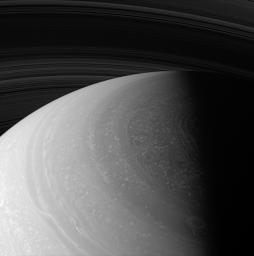As seasons change on Saturn, and sunlight creeps farther north, the region surrounding the north pole is steadily coming to light.
This scene reveals many features in Saturn's dynamic and beautiful atmosphere, including a detail largely obscured from the imaging cameras until now. On the terminator at center right is part of the polar hexagon, which was previously observed by Cassini's Visible and Infrared Mapping Spectrometer (VIMS) and Composite Infrared Spectrometer (CIRS). These instruments used heat radiated from Saturn to observe the polar hexagon (rather than reflected sunlight, as is the case in this view). The hexagon was first imaged by the Voyager spacecraft more than 25 years ago.
The view looks toward the unilluminated side of the rings from about 38 degrees above the ringplane and is centered on a region 63 degrees north of the Saturnian equator. The image has been brightened to show details at high northern latitudes, where solar illumination is presently weak.
The image was taken with the Cassini spacecraft wide-angle camera on Jan. 2, 2008 using a combination of spectral filters sensitive to wavelengths of polarized infrared light centered at 752 and 705 nanometers. The view was acquired at a distance of approximately 930,000 kilometers (578,000 miles) from Saturn. Image scale is 52 kilometers (32 miles) per pixel.
The Cassini-Huygens mission is a cooperative project of NASA, the European Space Agency and the Italian Space Agency. The Jet Propulsion Laboratory, a division of the California Institute of Technology in Pasadena, manages the mission for NASA's Science Mission Directorate, Washington, D.C. The Cassini orbiter and its two onboard cameras were designed, developed and assembled at JPL. The imaging operations center is based at the Space Science Institute in Boulder, Colo.
For more information about the Cassini-Huygens mission visit http://saturn.jpl.nasa.gov/home/index.cfm. The Cassini imaging team homepage is at http://ciclops.org.

 Planetary Data System
Planetary Data System












